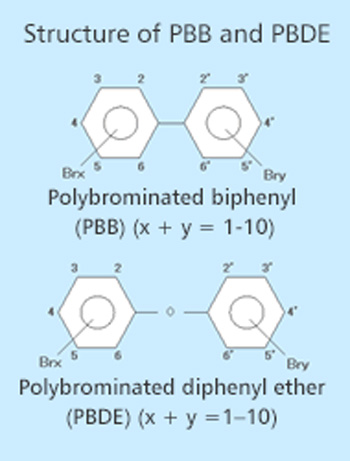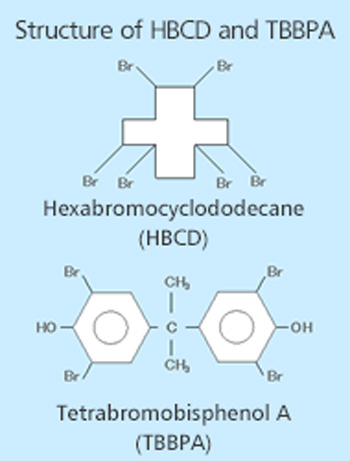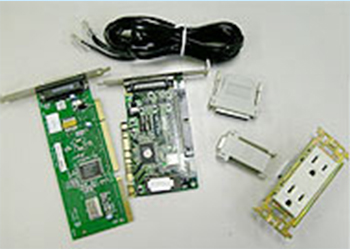Green Procurement Regulated Substances
and EU Regulated Substances
Analysis of Brominated Flame Retardants
(PBB, PBDE, HBCD, TBBPA, And TBP)
JFE-TEC can provide the analysis service on various brominated flame retardants in addition to PBB and PBDE!
Brominated flame retardants are the mostly widely used flame retardant in the world because of its effectiveness and low cost. Some of them were identified as persistent, bioaccumulative, and toxic to both humans and the environment and their use is restricted from July 2006 by the Restriction on Hazardous Substances RoHS)Directive implemented by EU.
- PBB: Polybrominated biphenyl
- PBDE: Polybrominated diphenyl ether
- HBCD: Hexabromocyclododecane
- TBBPA: Tetrabromobisphenol A
- TBP: 2,4,6-Tribromophenol
The RoHS Directive bans the placing on the EU market of electric and electronic equipment containing any one of 6 hazardous substances!
- The hazardous substances are
-
lead, cadmium, six valent chromium, mercury, polybrominated biphenyl (PBB), and polybrominated diphenyl ether (PBDE).
The Commission Decision 2005/717/EC on excepting decabromodiphenyl ether (decaBDE) from RoHS was invalidated and decaBDE was included from July 1 2008 in RoHS.The threshold value (maximum allowable concentration) of the hazardous substances specified by RoHS is 1,000 ppm (0.1%) in lead, mercury, six valent chromium, PBB, and PBDE and 100 ppm (0.01%) in cadmium, respectively
Topics
PBB and PBDE were registered in May 2009 on the list of the Persistent Organic Pollutants (POPs) Treaty.
Nine new persistent hazardous substances were listed in the POPs Treaty in the 4th Convention of International Treaty under the Stockholm Convention (POPs Treaty) held in Geneva from
May 4 to May 8, 2009.
In Japan measures to ban in principle the manufacture and the use of these substances will be implemented after reviewing the detailed content of the modified POPs Treaty and studying
the content of the Chemical Substance Control Law and the Export Trade Control Ordinance.
Japan is planning to submit requests for specific exception(s) in production and use of PFOS, its salts and PFOSF within the scope of the Treaty. Japan will establish the regulations
reflecting the content of the Treaty and controlling these substances in accordance to the current laws and regulations such as the Chemical Substance Control Law.
(Reference: News from the Ministry of the Environment, Japan published on May 12 2009 with the title of "4th International Congress in Stockholm Treaty (COP4)".
- Hexabromocyclododecane (HBCD) is one of the alternative substances for PBDE regulated by the RoHS Directive and has various isomers. This compound is regulated as Type 1 Monitoring Chemical Substances under the Chemical Substances Control Law and measures are undertaken to regulate the manufacture, the import and the use of HBCD. It is used as the flame retardant for foamed polystyrene, the curing agent/curing accelerator of adhesives, and the fiber coating agent.

- Tetrabromobisphenol A (TBBPA) is used as the flame retardant for plastics such as acrylonitrile-butadiene-styrene (ABS) resins, epoxy resins, polycarbonate, high impact polystyrene (HIPS), and phenol resins. TBBPA potentially releases brominated dioxins and brominated furans on heating and it is said that a very high potential exists for the formation of brominated dioxins/furans

- 2,4,6-Tribromophenol (TBP) is mainly used as the additive for resins and its use includes an intermediate for preservatives, antimicrobial agents, timber preservation agents, and flame retardants and for synthesis of polydibromophenylene oxide (flame retardant).

| Chemical compound | Regulation* | Analysis method |
|---|---|---|
| Polybrominated biphenyl (PBB) | Regulated under RoHS, WEEE, J-Moss, JIG-A, CSCL (Type I Monitoring Chemical Substance), new regulated substance under POPs | Extraction with solvent followed by high resolution GC-MS |
| Polybrominated diphenyl ether (PBDE) | Regulated under RoHS, WEEE, J-Moss, JIG-A, new regulated substance under POPs | Extraction with solvent followed by high resolution GC-MS |
| Hexabromocyclododecane (HBCD) | Risk assessment substance by RoHS, PoHS, REACH | Extraction with solvent followed by high resolution GC-MS |
| Tetrabromobisphenol A (TBBPA) | Regulated under CSCL (Type III Monitoring Chemical Substance), JIG-B | Extraction with solvent followed by high performance LC-MS |
| 2,4,6-Tribromophenol (TBP) | Regulated under PRTR System | Extraction with solvent followed by high performance LC-MS |
- * Abbreviation
-
- RoHS: EU Restriction of Use of Hazardous Substances Directive
- WEEE: Waste Electrical and Electronic Equipment Directive
- PoHS: Norwegian RoHS Directive
- CSCL: Chemical Substance Control Law
- J-Moss: The marking for presence of the specific chemical substances for electrical and electronic equipment
- JGPSSI: Japan Green Procurement Survey Standardization Initiative Level A and B designated substances


